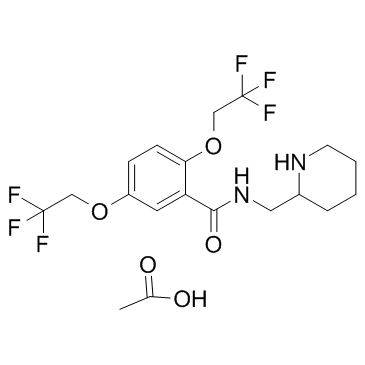flecainide acetate

flecainide acetate structure
|
Common Name | flecainide acetate | ||
|---|---|---|---|---|
| CAS Number | 54143-56-5 | Molecular Weight | 474.395 | |
| Density | 1.286g/cm3 | Boiling Point | 434.9ºC at 760mmHg | |
| Molecular Formula | C19H24F6N2O5 | Melting Point | 145-147℃ | |
| MSDS | Chinese USA | Flash Point | 216.8ºC | |
| Symbol |


GHS07, GHS08 |
Signal Word | Danger | |
|
Multiple modes of ryanodine receptor 2 inhibition by flecainide.
Mol. Pharmacol. 86(6) , 696-706, (2014) Catecholaminergic polymorphic ventricular tachycardia (CPVT) causes sudden cardiac death due to mutations in cardiac ryanodine receptors (RyR2), calsequestrin, or calmodulin. Flecainide, a class I antiarrhythmic drug, inhibits Na(+) and RyR2 channels and prev... |
|
|
Serum flecainide S/R ratio reflects the CYP2D6 genotype and changes in CYP2D6 activity.
Drug Metab. Pharmacokinet. 30 , 257-62, (2015) The aims of this study were to clarify whether the ratio of S- to R-flecainide (S/R ratio) in the serum flecainide concentration was associated with the stereoselectivity of flecainide metabolism, and to investigate the effects of the cytochrome P450 (CYP) 2D... |
|
|
A misguided 'pill in the pocket' approach with flecainide leading to cardiac arrest.
BMJ Case Rep. 2012 , doi:10.1136/bcr-2012-006868, (2012)
|
|
|
A case of near-fatal flecainide overdose in a neonate successfully treated with sodium bicarbonate.
J. Emerg. Med. 44(4) , 781-3, (2013) Flecainide is a class IC antidysrhythmic primarily indicated for ventricular dysrhythmias and supraventricular tachycardia (SVT). Class IC antidysrhythmic overdose has a reported mortality of 22%, and death results from dysrhythmias and cardiovascular collaps... |
|
|
Hypertonic sodium bicarbonate versus intravenous lipid emulsion in a rabbit model of intravenous flecainide toxicity: no difference, no sink.
Clin. Toxicol. (Phila.) 51(5) , 394-7, (2013) The use of intravenous lipid emulsion (ILE) as an antidote in non-local, anaesthetic drug toxicity has generated considerable interest. Flecainide is a lipophilic anti-arrhythmic with a significant cardiotoxic profile, with blockade of sodium and potassium ch... |
|
|
Long-term conservative management of a giant cardiac fibroma.
Acta Cardiol. 68(5) , 513-5, (2013) A giant cardiac fibroma was discovered during evaluation for a soft systolic murmur in an asymptomatic 2-week-old girl. Echocardiography and magnetic resonance imaging showed a large intraventricular solid mass developed at the expense of the left ventricular... |
|
|
A life-threatening flecainide overdose treated with intravenous fat emulsion.
Pacing Clin. Electrophysiol. 36(3) , e87-9, (2013) Flecainide is a Vaughan Williams Class Ic antidysrhythmic associated with PR, QRS, and QTc prolongation on the electrocardiogram and development of life-threatening cardiac toxicity in overdose. The cornerstone of treatment is fluid resuscitation and the admi... |
|
|
[Flecainide acetate].
Ann. Cardiol. Angeiol. (Paris.) 45(5) , 263-79, (1996) Flecainide acetate is a powerful antiarrhythmic initially used to treat ventricular arrhythmias. Despite an excess mortality in this indication and in the presence of heart disease, flecainide remains a good antiarrhythmic for supraventricular tachycardias in... |
|
|
Irreversible third-degree heart block and pacemaker implant in a case of flecainide toxicity.
Am. J. Emerg. Med. 31(9) , 1418.e1-2, (2013) An 82-year-old white woman was seen in the emergency department (ED) after ingesting 400 mg of flecainide in an attempt to treat an episode of dizziness and palpitations that occurred while she was gardening. Consequently, she developed bradycardia, hypotensi... |
|
|
Conversion of recent onset atrial fibrillation: which drug is faster?
Am. J. Emerg. Med. 31(9) , 1410-1, (2013)
|